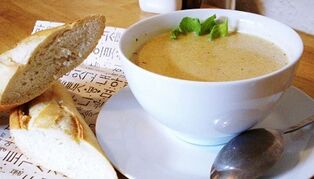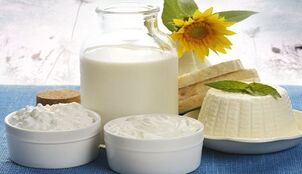
Pancreatitis is a serious disease of the pancreas characterized by impaired production of digestive enzymes. The main symptoms of the disease are postprandial pain in the left or right hypochondrium, heartburn, nausea, vomiting and upset stomach.
Strict adherence to diet is the key to treating pancreatitis. After all, the development of the disease is often caused by an unhealthy lifestyle, excessive consumption of alcohol and "junk" food.
Diet for pancreatitis helps patients reduce pain during the exacerbation of the disease and add a phase of remission. Nutrition is different in acute and chronic pancreatitis, but still has some similarities. Let's talk about them.
General nutrition guidelines for pancreatitis
The main requirement of the diet is to increase the amount of protein consumed and reduce the fats and carbohydrates in the main diet (if possible, they should be completely eliminated). In particular, you should avoid the consumption of granulated sugar, because it is 99% carbohydrate.
Coarse-grained fatty foods should be completely eliminated from the lives of patients with pancreatitis. After all, they put a heavy burden on the pancreas, as a result of which the body begins to produce large amounts of digestive enzymes, which are dangerous in this disease and can cause serious complications.
Doctors recommend that all patients with pancreatitis take vitamin complexes, which will help to compensate for the lack of vitamins and minerals in the body, usually caused by a limited diet.

Meals should be planned at the same time.
Eat in small portions 5-6 times a day to prevent excessive stress and overeating in the pancreas.
Diet for acute pancreatitis
As a rule, acute pancreatitis manifests itself as a sudden sharp pain in the stomach. The pain is unbearable and therefore forces a person to call an ambulance. The diet for acute pancreatitis is "zero" before the doctor's visit. Under no circumstances should you eat. Neither "light" nor "heavy".
It is allowed to take still mineral water before the doctor's visit, but not more than 3 glasses. They are allowed to drink only if the process of urination is normal.
Treatment of acute pancreatitis occurs only in a hospital setting. It is important to fast for the first two days. Only now it is allowed to drink hip water with mineral water. The total amount of fluid consumed should not exceed 5 glasses per day.
On the third day of treatment, the patient is allowed to eat fresh, low-calorie food that does not irritate the pancreas and increase the secretion.
The diet for pancreatic pancreatitis lasts one to two months after the main symptoms have subsided. You must leave completely during this time:
- fried and fatty foods;
- buns and pastries;
- acidic and smoked foods;
- pickles and canned foods;
- spicy and sweet;
- onions and garlic;
- alcoholic beverages;
- fatty meat and fish;
- sausage.
All foods must be heat treated. It should be boiled or steamed in water. Do not use oil, salt or spices during cooking.

The patient is allowed to eat only hot and grated food. It is recommended to use laxative fermented milk products - kefir, boiled milk before going to bed.
The duration of the diet is from 6 to 12 months. It depends on how it will affect a person's health in the future. If all nutritional recommendations are ignored, the disease can become chronic and the patient needs lifelong treatment.
Diet for chronic pancreatitis in remission
Chronic pancreatitis diet is slightly different from the above diet. In this case, the patient's diet is significantly expanded, but only in remission. During the period of exacerbation, the diet has a completely different nature, but more on that later.
In chronic pancreatitis, a person is allowed to consume proteins, which should practically exceed their daily intake, and at the same time allow the use of carbohydrates (sugar, honey, baked goods, baked goods, etc. ).
Foods that irritate the pancreas (hot spices, large amounts of salt, alcohol, etc. ) are a limitation.
The patient's diet should also be fractional. The number of meals is between 4 and 6 times. The food served should be hot. You do not need to crush it before eating.
Meat and fish products should not contain too much fat, otherwise it can lead to liver degeneration, which often occurs in chronic pancreatitis. Cottage cheese contains many useful substances, and therefore should simply be in the diet of the patient. However, you can only eat homemade cottage cheese, but not too greasy. It is forbidden to eat store-bought cottage cheese.
If a person can't give up bread, it is recommended to use yesterday's pastries or crackers (only gray or black bread) during the meal. You can also eat baked goods and pastries, but in limited quantities (provided that no more than one serving per day).
It is not recommended to drink pure milk due to poor digestion in pancreatitis. It can be added to teas or made into cereals and soups. Even if the patient tolerates milk well, he should not drink too much. The maximum dose is 200 ml.

Fermented milk products are very useful for patients with chronic pancreatitis. Cheese, which is on the list of forbidden foods in other stages of the disease, can also be consumed in remission, but not in large quantities, and you must feel good. The cheese should not be too salty or greasy.
Eggs cannot be eaten whole. Only egg white can be in the patient's diet. Can be used to steam omelets or add to soups.
The patient's diet should not contain too much fat (not more than 70 grams per day). In addition, most of them should consist of vegetable oils. They are better digested and do not overload the pancreas.
Diet for chronic pancreatitis during exacerbation
Diet for pancreatic pancreatitis during exacerbation is the same as for the acute form of the disease. The patient is prescribed fasting and is allowed to eat small amounts of fresh and low-fat food in case of positive dynamics.
If there is no deterioration in health, the patient's menu is gradually expanded. After 2-3 months, a person can eat as in remission.
Remember, this is a rough diet for pancreatitis. A complete list of permitted and prohibited products should be checked with your doctor. Only he will be able to formulate a proper diet, taking into account your health condition.














































































